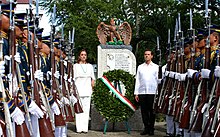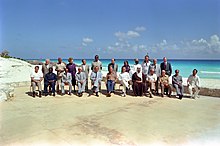Mexico–Philippines relations
 | |
Mexico |
Philippines |
|---|---|
Mexico and the Philippines share a common history dating from when both countries were conquered by the Spanish Empire. There were 200,000 Mexicans with Filipino descent residing in Mexico as of year 2000[update], mostly in the states of Colima, Guerrero, and Michoacán.[1]
Country comparison
History
Mexico and the Philippines share many traditions and customs, which derive from ties established over 400 years. Both countries were dominated by the Spanish crown. In 1521 Hernán Cortés conquered the Aztec empire; and in the same year, Ferdinand Magellan travelled to Asia and claimed the Philippine islands for the Spanish crown. In 1543, after their discovery, the explorer Ruy Lopez de Villalobos sailed from Barra de Navidad, Jalisco, Mexico, to recognize and name these islands. They were named the Philippine Islands, in honor of Prince Felipe of Asturias. [2] In 1565, Spanish Governor General Miguel Lopez de Legazpi claimed the Philippines as a Spanish Colony and designated Manila as its capital in 1571. Due to its distance from Spain, the Spanish Government assigned Manila's administration and government to the Viceroyalty of New Spain for two and a half centuries. Evangelization and commercialization constituted the core of intercontinental ties between Asia and America that materialized with the Manila-Acapulco galleons trade. Due to the grand exchange with the Philippines in those days, many cultural traits were adopted by one another, with Mexicans remaining in the Philippines, and Filipinos establishing in Mexico, particularly the central west coast, near the port town of Acapulco. Many Nahuatl words were adopted and popularized in the Philippines, such as Tianggui (market fair) and Zapote (a fruit).
Under Mexican administration
The Philippines was built as a Spanish colony in 1565, when Miguel Lopez de Legazpi was appointed Governor General. He selected Manila as the capital in 1571. The islands were very remote, so the Spanish Royal Family commissioned the Philippine government administration to the Viceroyalty of New Spain (Mexico) for over two and half centuries, In 1815 the insurgent movements in Mexico forced Spain to take control of the islands of the Pacific.
Hence many of the Filipino governors were Mexican-Creole. The army was recruited from all the populations of New Spain, which led to ethnic and cultural mingling between Mexicans and Filipinos. Evangelization and commerce connected America and Asia, exemplified by the galleon trade. The trade between Canton and Acapulco passed through Manila, where Chinese ships came laden with silks and porcelain to be sent to America, in exchange for silver. And the exchange of ideas accompanied the exchange of products.
Independent relationships

In 1842, after the colonial period, Mexico stationed an independent representative in Manila. However, the earliest reference to a Mexican diplomat in the Philippines is found during the Revolution, in the Porfiriato, with the appointment, in 1878, of Evaristo Hernandez Butler, as Consul.
In 1935, the Secretary of Foreign Affairs of Mexico, Emilio Portes Gil, appointed the first Filipino pilot and painter, Alfredo Carmelo de las Casas, as Honorary Consul of Mexico in the Philippines. He remained in that position until 1954.
Another significant Mexican presence in the Philippines was the 201 Squadron during World War II. Mexico participated in the Pacific campaign against the Japanese, with a contingent of the Mexican Expeditionary Air Force, which arrived in Manila on April 30, 1945, commanded by Colonel Antonio Cardenas Rodriguez.
After Philippine independence
The independence of the Philippines brought forth a new era of relations between these countries. Mexico dispatched an envoy to participate in the festivities to celebrate the birth of the Southeast Asian nation. Diplomatic ties between both countries were formalized on April 14, 1953. The year of 1964 was decreed the "Year of Philippine-Mexican Friendship" to celebrate the Fourth Centennial of the expedition of Miguel López de Legazpi. In modern day, the conquest of the Philippines is seen as a Spanish initiative, while Mexico is viewed as a country of historical link and friendship, and several groups intend on strengthening the bond between the two countries.[3]
The Philippine Legation in Mexico opened its doors, with Carlos Gutiérrez Macias, as Minister Extraordinary and Plenipotentiary, on September 17, 1953. It was elevated to the rank of an embassy on July 25, 1961.
Both countries share a multitude of bilateral agreements including cooperation in Science, Technology, Culture, Tourism, Education, and the fight against illegal drug trafficking and abuse.
State visits

During the presidency of Diosdado Macapagal, the president of Mexico, Adolfo López Mateos, paid a state visit to the Philippines from October 20 to 23, 1962, to respond to the trip to Mexico in 1960, by then Vice President Macapagal. 1964 was designated the "Year of the Mexican-Filipino Friendship" to celebrate the fourth centenary of the expedition of Miguel López de Legazpi.
President Gloria Macapagal Arroyo visited Mexico on November 21, 2001 to attend the international conference of the Christian Democratic parties, at which President Vicente Fox represented Mexico. She was again the guest of Mexico, in October 2002, when the Tenth APEC Leaders Meeting was held in La Paz, Baja California.
In November 2011, former Mexican First Lady Margarita Zavala made a two-day special visit to the Philippines. Zavala met the Philippine President in Malacañan Palace. She also visited Fort Santiago and the Nayong Kabataan shelter for children.[4]
Mexican President Enrique Peña Nieto undertook a state visit to the Philippines on November 17, 2015 on the sidelines of the APEC Economic Leaders' Meeting in Manila. During his state visit, President Nieto and Philippine President Benigno Aquino III discussed enhancing trade relations and witnessed the signing of bilateral agreements on the avoidance of double taxation, tourism cooperation, and combating illegal drug trade.[5][6]
- President Adolfo López Mateos (October 1962)
- President José López Portillo (November 1978)
- President Ernesto Zedillo (November 1996)
- President Enrique Peña Nieto (November 2015)
- Presidential visits from the Philippines to Mexico[10]
- President Ferdinand Marcos (October 1981)
- President Fidel V. Ramos (May 1997)
- President Gloria Macapagal-Arroyo (November 2001 & October 2002)
Agreements signed
To date, Mexico and the Philippines have signed the following agreements:
- Bilateral Air Transport Agreement, signed in Washington in 1952.
- Cultural Agreement signed in Mexico in 1969.
- Agreement on Scientific-Technical Cooperation in Agricultural Matters, signed in 1994
- Agreement on Cooperation in the Field of Tourism in 1995.
- Visa Abolition Agreement ordinary, signed in Mexico in 1997.
- Agreement on Cooperation in Combating Illicit Trafficking and Abuse of Narcotic Drugs.
- Basic Agreement on Technical and Scientific Cooperation in 1997.
- Psychotropic Substances and Precursors Control, signed in Mexico in 1997.
- Memorandum of Understanding on Academic Cooperation between the Ministry of Foreign Affairs of Mexico and the Department of Foreign Affairs of the Philippines, signed in 1997.
In 2012, Philippine Foreign Secretary Albert Del Rosario signed a two bilateral agreements with Mexican Foreign Minister Patricia Espinosa in Mexico last February. These agreements include establishing a Joint Bilateral Consultation Meeting and providing for the exchange of information, training modules, and scholars for diplomatic training.[11]
Trade and commerce
In 2017, two-way trade between both nations amounted to $2.5 billion USD.[12] The five most important Mexican export products to the Philippines are: industrial manufacturing, semiconductors, organic and inorganic chemicals and sugar preparations. Mexico is the third largest importer from the Philippines in the Americas, after the United States and Canada and is the seventh largest exporter to the Philippines. The Mexican cement producer Cemex, planned to raise the cement production capacity in the Philippines by 1.5 million metric tonnes per year. Mexican beverage conglomerate FEMSA S.A.B de C.V. is now planning to set up at least one plant in the Philippines for its subsidiary Imbera, which manufactures commercial refrigeration equipment.[13][14]
Mexican business council (Philippines)
This Council was created in 1996 as a non-profit institution in order to strengthen business ties between Mexico and the Philippines. Council members are renowned and recognized businessmen from both countries. This co-chaired by Manuel Uribe Castaneda for Mexico and Benigno Ricafort for the Philippines.
Resident diplomatic missions

- Mexico has an embassy in Manila[15]
- The Philippines has an embassy in Mexico City[16]
See also
References
- ^ Filipinos in Mexican History (archived from the original on 2007-10-15)
- ^ Template:Sp icon Ministry of Foreign Affairs. "Bilateral relations: Mexico-Philippines". Mexican Embassy in the Philippines. Retrieved April 16, 2009.
- ^ Relaciones bilaterales entre México y las Filipinas (in Spanish)
- ^ "Aquino hosts luncheon for visiting Mexican first lady". InterAksyon. November 23, 2011.
- ^ Villanueva, Marichu (September 17, 2015). "Mexican president coming for state visit". The Philippine Star. Retrieved November 2, 2015.
- ^ Sabillo, Kristine Angeli (November 17, 2015). "Aquino, Nieto discuss trade, proposed Mexico-PH action plan". Philippine Daily Inquirer. Retrieved November 22, 2015.
- ^ President Fidel V. Ramos visits Mexico (in Spanish)
- ^ Presidente Ernesto Zedillo: Gira Internacional por Asia (in Spanish)
- ^ History of diplomatic relations between Mexico and the Philippines (in Spanish)
- ^ "Presidential Trips: The full list". Official Gazette. Retrieved November 2, 2015.
{{cite web}}: Italic or bold markup not allowed in:|publisher=(help) - ^ "Philippines, Mexico Sign Bilateral Accords". Manila Bulletin. February 18, 2012.
- ^ Mexican Ministry of the Economy: Philippines (in Spanish) Archived 2016-04-25 at the Wayback Machine
- ^ "Cemex to invest $65M to raise production in PH". ABS-CBN. September 19, 2012.
- ^ "Coca Cola FEMSA eyeing PHL manufacturing plant". GMA News. January 23, 2013.
- ^ Embassy of Mexico in Manila (in English and Spanish)
- ^ Embassy of the Philippines in Mexico City






